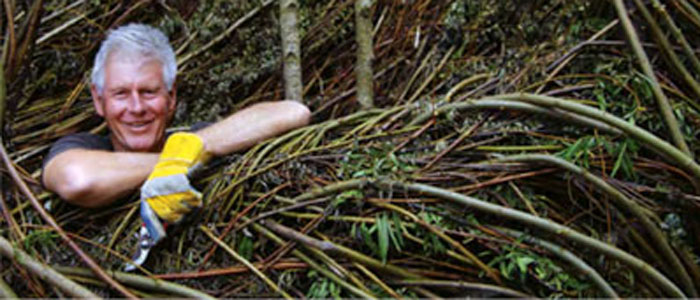 PHOTO: JAMES FRAHER
From coast to coast in the U.S. and as far away as Denmark, France, and Scotland, parks, museums, and private homes have served as settings for sculptor Patrick Dougherty’s striking installations. His work is also the subject of a new documentary film, Bending Sticks: The Sculpture of Patrick Dougherty (bendingsticksthefilm.com).
PHOTO: JAMES FRAHER
From coast to coast in the U.S. and as far away as Denmark, France, and Scotland, parks, museums, and private homes have served as settings for sculptor Patrick Dougherty’s striking installations. His work is also the subject of a new documentary film, Bending Sticks: The Sculpture of Patrick Dougherty (bendingsticksthefilm.com).
W
hen he was at the University of Iowa in the late 1960s, Patrick Dougherty was too busy studying hospital and health administration to have time for art. But that didn’t keep him from stopping by the art department on his way to class.
"I would look longingly in the door, sigh, and think, ‘It would be so great to do that,’" Dougherty says. "But I never could. It took me a few years to move from that stance to, ‘I HAVE to do that.’"
Once he came to that decision, Dougherty moved to a 10–acre farm near the University of North Carolina–Chapel Hill, constructing a cabin from reclaimed logs that became a monument to do–it–yourself construction. He also went back to school at UNC.
While studying sculpture, Dougherty decided that clay was too cumbersome. So, he started using a much more unconventional material: sticks, which he bends into shapes to construct environmental structures that can be as big as a house.
"The idea to work with sticks came from their availability and versatility, which made them easy to use to work big," Dougherty says. "Plus, they don’t have to be prepared; you just go to work with them."
Dougherty’s stick sculptures aren’t built to last and eventually haveto be taken down when they get too weather–beaten. But they’re striking works that seem to sprout organically out of the landscapes where they’re set. evoking the flow of wind or water currents, they appear to whirl through trees or along walls.
Most of his sculptures also have the whimsical feel of a playground funhouse, big enough to walk inside. Projects typically take three weeks to complete, and Dougherty’s process draws in the surrounding community through the use of volunteers. Such partnerships help start a dialogue, which seems to interest Dougherty as much as the finished work.
"It’s hard for people to hate an object that their neighbors are working on," he says. "The three–week timeframe is good; drama can build. People have time to accommodate it, see the construction, speak to me a few times. Maybe early on they’ll tell me it’s stupid. But they follow along and finally come to the conclusion that it’s compelling and has value."

